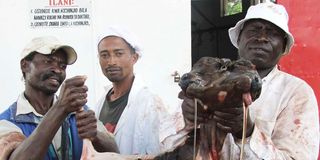Understanding birth defects in livestock

Workers at the Kitengela slaughter house hold a dead calf born with two heads that was removed from a slaughtered cow in this photo taken on March 15 2010. Some developmental defects are minor, such as a missing tail.
What you need to know:
- Farmers should also avoid breeding animals with a record of producing monsters because the traits are inheritable.
- Genes may also change due to damage by chemicals such as alcohol and tobacco in humans, medicines as with the case of the dewormer albendazole or environmental pollution
This week has been very interesting for me in my conversations with farmers on the internet and on phone. It all started when a farmer sent me a photo of a calf born with two heads.
I also incidentally heard a radio discussion where a caller from somewhere in Western Kenya was claiming that a cow had given birth to a calf with two heads in his village.
The caller said they had been shocked as they had never seen such an occurrence. He went ahead to suggest it could be a bad omen. Livestock, and even humans, being born with what are termed birth defects is a normal occurrence but not a common one. Majority of all births are of complete off-springs. It is therefore a common assumption that every birth yields a wholesome newborn.
In our younger days, men had the bad habit of waiting for the news of the birth of their child in a pub nearest the hospital when their wives went into labour. There, they would call their friends and announce they were expecting a son. Daughters never featured in that discussion. I always cautioned my friends that it was best to wait at home or at the hospital because there was no guarantee the form of baby that could be delivered. Biology has a tendency to surprise us when we least expect. The actual term for birth defects is foetal developmental defects or anomalies because in the real sense, the defects occur during the development of the foetus and not at birth. The defects are caused by many factors. The most common cause is genetic defects where genes have changed through a process called mutation.
Genes may also change due to damage by chemicals such as alcohol and tobacco in humans, medicines as with the case of the dewormer albendazole or environmental pollution. Cattle that consume the legume lupine at about 40 to 70 days of pregnancy can develop foetal developmental abnormalities.
Defects in the developing foetus may also occur due to physical factors such as too much heat or pressure. Nutritional deficiencies cause developmental anomalies in the growing foetus by interfering with chemical processes that influence the expression of genes.
Infections by viruses and some bacteria during pregnancy may also interfere with development of the foetus. The Akabane or blue tongue virus, for instance, is known to cause foetal developmental deformities in cattle.
Some developmental defects are minor, such as a missing tail. Others are major where the foetus is disfigured, not recognisable as a newborn of the species or the changes cannot even sustain life. Heavily abnormal foetuses are called monsters and the condition is called monstrosity.
The picture sent to me of a calf with two heads and the radio report of another similar case motivated me to ask farmers, in a WhatsApp group I am in, to share any experiences they have had with monstrosities. They did not disappoint. I received three more monstrosity photos. The first one was a lamb from Nandi County. It was so disfigured that one could not easily tell what species it was. The sender told me the lamb was born normally but it could not stand or vocalise. The mouth was too deformed to be able to suckle. I advised the farmer to destroy the monster. I enquired about the lamb monster and the farmer told me he had dewormed the mother sheep with albendazole at around the second month of pregnancy. I informed him the monstrosity could have been caused by the albendazole. The drug is known to cause foetal developmental abnormalities if given in early to mid-pregnancy. The second picture shared was that of a calf born with a monstrosity called arthrogryposis or hooked joints from Makueni County. The condition is also called arthrogryposis multiplex congenita, abreviated AMC.
With AMC, calves have stiff crooked joints in more than one part of the body. The stiffness involves the joints, tendons and muscles. If the situation affects a large number of joints, the calf is unable to stand, eat or drink. The condition is caused by defective genes. It is most common in Aberdeen Angus and Charolais cattle but may occur in any breed of cattle. The most surprising report from the farmers was a discoid monster, sent all the way from Kilifi County. I have read about the monstrosity but I have never encountered one. It is scientifically called acardius amorphus. The monster was spherical and a bit flattened on the lower and upper sides. It was fully covered with black and white hair. On the underside, there were two small holes, an umbilical stump and two holes apart like the sockets of the eyes. The farmer said the monster was born alive but “died” soon after the umbilical cord was severed. This monster does not have a heart and therefore it “dies” once the umbilical cord is cut.
The two-headed calf is called a dicephalic monster. In some cases a monster may be born with more than one head and is termed polycephalic. Most die and polycephalic calves do not survive long after birth.
The best way to control the development of monsters is to avoid exposing animals to the chemicals that may cause the problem. Farmers should also avoid breeding animals with a record of producing monsters because the traits are inheritable.





